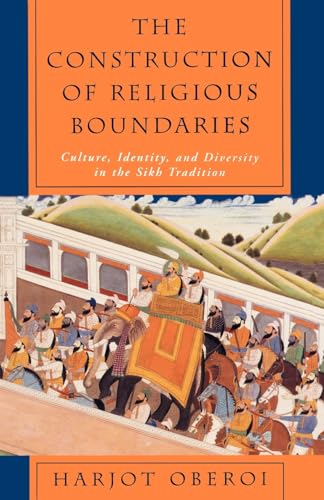The Construction of Religious Boundaries: Culture, Identity, and Diversity in the Sikh Tradition
Oberoi, Harjot
About the Book
Description:
Seller Inventory # SHM.576P
About this title:
Synopsis:
In this major reinterpretation of religion and society in India, Harjot Oberoi challenges earlier accounts of Sikhism, Hinduism and Islam as historically given categories encompassing well-demarcated units of religious identity. Through a searching examination of Sikh historical materials, he shows that early Sikh tradition was not concerned with establishing distinct religious boundaries. Most Sikhs recognized multiple identities grounded in local, regional, religious, and secular loyalties. Consequently, religious identities were highly blurred and several competing definitions of what constituted a Sikh were possible.
In the closing decades of the nineteenth century, however, the Singh Sabha, a powerful new Sikh movement, began to view the multiplicity in Sikh identity with suspicion and hostility. Aided by social and cultural forces unleashed by the British Raj, the Singh Sabha sought to recast Sikh tradition and purge it of diversity. The ethnocentric logic of a new elite dissolved alternative ideals under the highly codified culture of modern Sikhism.
A study of the process by which a pluralistic religious world view is replaced by a monolithic one, this important book calls into question basic assumptions about the efficacy of fundamentalist claims and the construction of all social and religious identities. An essential book for the field of South Asian religions, this work is also an important contribution to cultural anthropology, postcolonial studies, and the history of religion in general.
From the Back Cover: In this major reinterpretation of religion and society in India, Oberoi challenges earlier accounts of Sikhism, Hinduism, and Islam as historically given categories encompassing well-demarcated units of religious identity. Through an examination of Sikh historical materials, he shows that early Sikhism recognized multiple identities based in local, regional, religious, and secular loyalties. As a result, religious identities were highly blurred and competing definitions of Sikhism were possible. In the closing decades of the nineteenth century, however, the Singh Sabha, a powerful new Sikh movement, began to view the multiplicity in Sikh identity with suspicion and hostility. Aided by cultural forces unleashed by the British Raj, the Singh Sabha sought to recast Sikh tradition and purge it of diversity, bringing about the highly codified culture of modern Sikhism. A study of the process by which a pluralistic religious world view is replaced by a monolithic one, this book questions basic assumptions about the efficacy of fundamentalist claims and the construction of all social and religious identities.
Bibliographic Details
Title: The Construction of Religious Boundaries: ...
Publisher: University of Chicago Press
Publication Date: 1994
Binding: Soft cover
Condition: good
